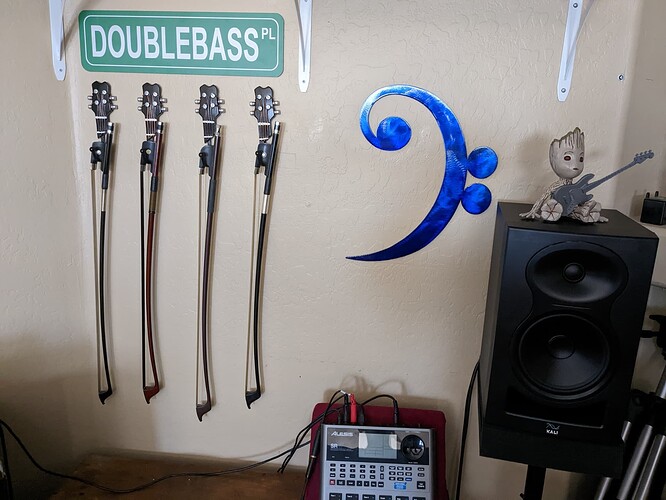whoa.
Very cool.
I was about to order one, but looking in my little room here, I don’t think I can spare the horizontal space!!
Seems very convenient though.
It really does eat up horizontal space (more like diagonal space), but it sure is worth the sacrifice (if you can spare it).
something I really don’t understand is why sometimes the instrument is called “upright bass” and sometimes “double bass”. is there a difference ? what does it means ?
probably a very naive question from a non-native english speaker …
Good question, Laurent, I am curious as well.
Did a quick Google and came up with same instrument, different styles of music call it different names.
And what about contrabass?
I used to think Ubass was short for upright until I finally saw one.
Just another term for double bass
It’s the same thing. They are called double bass simply because they are twice as low as the cello, which was once considered the lowest instrument in an orchestra. They are also called contra bass (French for double bass), bass fiddle, bull fiddle, doghouse bass, and a few other nick names.
Most professional bassists simply refer to it as the double bass. I call my acoustic upright my double bass so as not to confuse it with my electric upright bass (EUB).
at least one thing I can say ![]() in french we call this instrument “contrebasse” which sounds pretty much like “contra bass” in english.
in french we call this instrument “contrebasse” which sounds pretty much like “contra bass” in english.
thank you all for the explainations ! it makes all this much more clear to me.
I’ve always wondered about this one.
Double bass made sense to me, because the bass is an octave below the cello and - in older musics (coming out of the Baroque) it would play the same line as the cello, only lower.
Doubling the bass / double low in the bass clef. That made sense.
The Contrabass was weirder. @terb , I thoght ‘contre’ (or contra in italian/latin) was ‘against’ or ‘instead of’?
There are contrabass instruments in other families, so in practice it means “an octave below the bass” in whatever instrument family it shows up in… still. I hunted around a bit to try and figure out why that word got used, but couldn’t figure it out.
Stand up bass and Upright bass were logical to me (this is based only on my own conjecture and experience, mind you) as an easy way to differentiate them from electric bass. These terms really only show up in popular music, where the electric bass became the default thing people think of when they hear “bass”.
Fun questions.
The line is further muddled by the electric upright bass. In my world (and in the worlds of many other people), there exists electric bass guitars, an electric upright bass (EUB), and an acoustic upright bass (double bass). In conversations, I must refer to each instrument as such so as to not cause confusion.
yeah, “contre” means “against” (more than “instead of”). but I’ve done a little research to find out that, in music, “contre” means also “shifted by one octave” (up or down). a “contre-tenor” is a singer that sings one octave higher than a tenor, and a “contrebasse” plays one octave bellow a normal bass.
totally makes sense ! that’s funny and interesting
I always thought it was 2 octaves, thus the term “double” bass. I could be wrong of course.
Awesome.
Yes!
I forgot, we have the same word for Counter-Tenors here too.
Shifted by one octave.
Thanks!! This fills a gap that’s been bothering me for years.
those days I’m watching videos on a french upright youtube channel. the guy says that most players use a 3/4 instrument, and that 4/4 doublebasses are quite rare. I’ve been very surprised, I was sure that all adults play a 4/4.
so, if I try to find a doublebass, I guess I should search for a 3/4 … that’s a little bit confusing.
Yes, you’ll want a 3/4. Hardly anyone plays 4/4.
Right?
When I was shopping for my upright, I tried a 7/8 size bass. It was enormous. Too big for me to play, and I’m very tall with big hands. And still not a full size bass.
But it sounded incredible!!
I think Charles Mingus’ main bass was a 7/8?
If you’re under 6 ft / 2 meters, it might even be nice to find a 5/8 size bass. They are still huge, but scaled back just a bit, and it makes the transition from electric much easier.
Otherwise, the majority of basses are 3/4 size.
I’m 1,82 meter (almost 6 ft)
is a 1/2 really way smaller than a 3/4 ?
I’m 5’ 7" and play a 3/4. I have the end pin almost fully retracted and the scroll is slightly higher than my head. The F position on the E string is at the level of my eyebrows, which I believe is where it’s supposed to be
